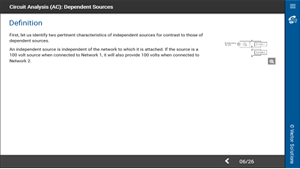Circuit Analysis (AC): Dependent Sources
Upon completion of this course, you will:
-
Know what a dependent source is
-
Know where dependent sources are used
-
Understand the difference between a dependent source and an independent source
-
Know how to convert dependent current sources to dependent voltage sources
-
Know how to convert dependent voltage sources to dependent current sources
Current, voltage, and resistance. 2 hour
Ohm's Law, and power. 1 hour
Series and parallel resistors. 1 hour
Current and Voltage in series circuits. 1 hour
Current and Voltage in parallel circuits. 1 hour
Power. 1 hour
Kirchhoff's Laws. 1 hour
Voltage Divider Rule and Current Divider Rule. 1 hour
Open and short circuits, notation and source resistance. 1 hour
Thevenen's Theorem. 1 hour
Norton's Theorem. 1 hour
Superposition Theorem. 1 hour
Mesh Analysis. 2 hour
Node Analysis. 2 hour
DC Circuits, electron flow version
Same topics as conventional flow version
AC Circuits
Sinusoidal generation and definitions. 1 hour
Sinusoidal general format and phase relationships. 1 hour
Average Value and Effective Value. 1 hour
Complex Numbers and Phasors. 2 hour
Dependent Sources. 1 hour
Mesh Equations with dependent sources. 1 hour
Mesh Equations with independent sources. 2 hour
Node Equations with dependent sources. 1 hour
Node Equations with independent sources. 2 hour
RLC circuit response. 1 hour
Source Conversions. 1 hour
Series and Parallel Circuits. 2 hour
Series and Parallel Networks. 2 hour
Thevenin's and Norton's Theorem. 1 hour
AC Power. 2 hour

